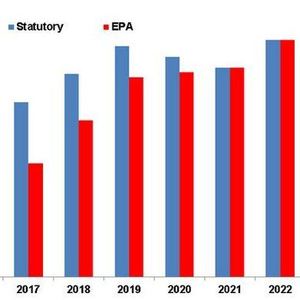Illinois economists examine long-term trajectory of proposed RVO

June 18, 2015
BY Susanne Retka Schill
What would the long-term implications be, if the U.S. EPA maintains the policy trajectory outlined in the May 29 proposed renewable volume obligations (RVO)? University of Illinois economists Scott Irwin and Darrel Good analyzed that question in the third in a series of FarmDocDaily posts, “Implementing the RFS with a "Push" Strategy: What Happens after 2016?”
Based on language in the EPA proposal, they write, “We assume that over time, the EPA will expand the magnitude of the push implied in the most recent proposal.” The proposal lays out the RVO’s for 2014, 2015 and 2015. Using that as the base, the economists project what might happen through 2022 and compare that with the statute establishing the renewable fuels standard (RFS). One assumption made is that the cellulosic mandate continues to be written down, the biodiesel mandate continues to increase each year and domestic gasoline and diesel consumption in 2017-2022 stabilizes at the projected level for 2016.
After stating the assumptions, the pair offer multiple tables showing the magnitude of the expected annual write down from statutory requirements and the magnitude of the advanced biofuels gap. The EPA’s write down of the statutory levels of the RVO compared to the statute narrows fairly quickly, they conclude and disappears by 2022.
Advertisement
Advertisement
“The EPA signaled an important change in direction for setting annual RFS standards in its recent preliminary proposal for 2014-2016,” Good and Irwin write. “The proposal indicates the EPA is serious about pushing RFS standards past the E10 blend wall. We examined the implications of the EPA continuing this policy direction after 2016 and found that the size of the total gap in the RFS mandates, or the ‘push,’ grows surprisingly quickly. For example, the total gap exceeds 2 billion gallons by 2018 and grows to 3 billion gallons in 2022.”
Future analysis will look at different scenarios in how the gap might be filled.
Advertisement
Advertisement
Related Stories
The U.S. Department of Energy’s Office of Energy Efficiency and Renewable Energy is soliciting public comments on a preliminary plan for determining provisional emissions rates (PER) for the purposes of the 45Z clean fuel production credit.
A new study published by the ABFA finds that the U.S. EPA’s proposal to cut the RIN by 50% for fuels made from foreign feedstocks, as part of its 2026 and 2027 RVOs, could stall the growth of the biomass-based diesel (BBD) industry.
Reps. Mike Flood, R-Neb., and Troy A. Carter, Sr., D-La., on July 21 reintroduced the SAF Information Act. The bill directs the U.S. EIA to more explicitly include SAF data in its weekly and monthly reports.
The U.S Department of Energy Bioenergy Technologies Office, in partnership with the Algae Foundation and NREL, on July 21 announced the grand champion and top four winning teams of the 2023 - 2025 U.S. DOE AlgaePrize Competition.
The European Commission on July 18 announced its investigation into biodiesel imports from China is now complete and did not confirm the existence of fraud. The commission will take action, however, to address some systemic weaknesses it identified.
Upcoming Events










